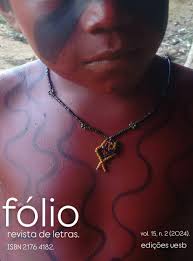Vozes ribeirinhas e a realidade de um ser mítico: a lenda do Boto no contexto do Igarapé-Miri na Amazônia paraense
DOI:
https://doi.org/10.22481/folio.v15i2.15376Palavras-chave:
Contexto ribereño, Leyenda del Boto, Narraciones orales, Realidades amazónicasResumo
Este trabajo pretende llevar a cabo una lectura acerca de la Leyenda del Boto (Leyenda del Bufeo colorado del Amazonas), a partir del imaginario colectivo de Igarapé-Miri, una localidad ribereña ubicada en el interior amazónico paraense. Tenemos en cuenta que el Boto es uno de los personajes más sobresalientes de la tradición oral de región, tratando de comprender cómo este ser sobrenatural natural (Loureiro, 2015) es parte de la cotidianidad de los pueblos que habitan las riberas de los ríos, al tiempo que reflexionamos sobre el papel que ejerce el mito en el contexto en cuestión. Para eso, se ha llevado a cabo una revisión de literatura y, al mismo tiempo, un trabajo de campo para ampliar y profundizar los conocimientos teóricos sobre la leyenda y todo lo que ello conlleva. Esto último a través de conversaciones libres (Severino, 2016), informales y espontáneas (Magán, 2010), de manera que pudimos cosechar las informaciones anheladas de manera amistosa y entusiasta, esenciales para la elaboración de este trabajo. La investigación está apoyada en autores como Araújo (2022), Farias (2021), Colombres (2016), Chávez (2017), Portocarrero (2016), Magán (2008; 2010), Cascudo (2008; 2010), Barbosa Rodrigues (1881), entre otros. Los resultados demuestran que el popular Boto se funde y se confunde con la realidad, al tiempo que asume un papel sumamente relevante en la cotidianidad de los lugareños. Así pues, no quedan apenas dudas sobre la existencia de este ser mítico.
Downloads
Referências
ARAÚJO, Gracineia dos Santos. Apreciaciones en torno al carácter universal de las leyendas orales: una mirada a partir de la realidad amazónica brasileña. Revista Caligrama, Belo Horizonte, v. 27, n. 2, p. 75-90. 2022.
BARBOSA RODRIGUES, J. Lendas, crenças e superstições. Revista Brazileira,
tomo X, p. 24-47. 1881.
_____. Poranduba amazonense, ou kochiyma-uara porandub. Anais biblioteca
Nacional. Volume XV. fasc. 2 p. 1-334, 1872-1887.
CASCUDO, Luís da Câmara. Dicionário do Folclore Brasileiro. Rio de Janeiro:
Ediouro, 2005.
_____. Literatura oral no Brasil. São Paulo: Global, 2008.
CASTILHO, L.H; CORRÊA, Paulo Maués. (org). 2017. Amazônia entre ensaios.
Belém: Paka-Tatu, 2017.
COLOMBRES, Adolfo. Seres mitológicos argentinos. Buenos Aires: Colihue,
CRUZ, Ernesto. 1945. Igarapé-Miry: Fases de sua formação histórica. Belém:
oficinas Gráficas da Revista da Veterinária.
COSSON, Rildo. Círculos de leitura e letramento literário. São Paulo: Contexto,
D'OLIVEIRA, Agostinho Monteiro Gonçalves. Crônica: Igarapé-Miry. Belém-Pará:
Typ. da Imprensa Oficial. 1889.
FARIAS, David Rodrigues. O comércio de escravos no Vale do Tocantins/PA,
-1887. Orientador: Francivaldo Alves Nunes. 2021. 189 f.
Dissertação (Mestrado) - Instituto de filosofia e ciências humanas,
Belém, 2021.
GARCIA, Graça Lobato; LOBATO, Eládio. Memória dos engenhos do Baixo
Tocantins: Antigos engenhos de aguardente; municípios de
Abaetetuba e Igarapé-Mirí. Belém: Edição do autor, 2011.
GONÇALVES, Cristianna Costa; ARAÚJO, Gracineia dos Santos. El
(des)encantamiento del Boto: reflexiones en torno a la concienciación
sobre la violencia sexual en el contexto amazónico paraense, a partir
de las leyendas orales como recurso didáctico en la clase de Español
como Lengua Extranjera – ELE. Revista Litteris, n. 30, p. 1-29, 2022.
IBGE- Instituto Brasileiro de Geografia e Estatística. Censo Brasileiro de 2022. Rio de Janeiro: IBGE, 2023.
LAPESA, Rafael. Introducción a los estudios literarios. Madrid: Cátedra, 1975.
KRENAK, Ailton. Futuro ancestral. 1ª ed. São Paulo: Companhia das Letras,
LOUREIRO, João de Jesus Paes. Cultura amazônica: Uma poética do imaginário.
ª ed. Manaus: VALER, 2015.
MAGÁN, Pascuala Morote. La importancia de la literatura de tradición oral:
entrevista a Pascuala Morote Magán. Revista Educación y Pedagogía,
v. 20, n. 50, p. 177-190, 2008.
_____. Aproximación a la literatura oral. La leyenda entre el mito, el cuento, la
fantasía y las creencias. Valencia: Perifèric ediciones, 2010.
NASCIMENTO, Sônia Viana. Igarapé-Miri: a passagem da escravidão ao trabalho
livre, numa região de engenhos (Grão-Pará: 1843-1888). Dissertação
(Mestrado). Instituto de Filosofia e Ciências Humanas. Universidade
Federal do Pará, 2017.
SEVERINO, Antônio Joaquim. Metodologia do trabalho científico. 24ª ed. São
Paulo: Cortez, 2016.
ZULUAGA GÓMEZ, V. Mitos y leyendas de los Embera – Chamí, 1997.
Disponible en: https://hdl.handle.net/11059/4877
Downloads
Publicado
Edição
Seção
Licença
Copyright (c) 2024 fólio - Revista de Letras

Este trabalho está licenciado sob uma licença Creative Commons Attribution-NonCommercial 4.0 International License.












